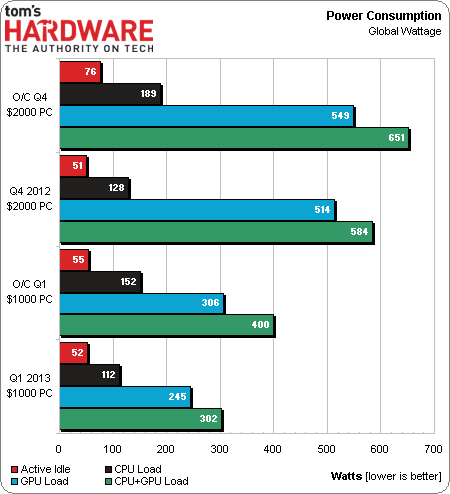System Builder Marathon, Q1 2013: $1,000 Performance PC
Power, Heat, And Efficiency
The presence of only one graphics card gives our current build a big advantage in power consumption. It also proves that we were wrong to assume we'd need more than a 380 W power supply. Our measurements apply to the complete build, including energy lost as heat within the PSU. The 400 W maximum input reflected for our tuned configuration corresponds to a 340 W output at 85% efficiency.
Our current build’s CPU also runs much cooler at 4.40 GHz compared to last quarter's overclocked build. This is in spite of the previous build’s use of a nearly identical CPU cooler, the same core architecture, and a lower overclocked voltage. We could credit part of the current system’s relatively cool operation to our own side-fan placement optimization, but we also know that Hyper-Threading facilitates better utilization. So, doubling up on Prime95 threads could very easily tax that platform more acutely, hurting thermal performance.
Since our new system is the competitor, we used the previous build’s stock performance as the baseline for our calculations. The new build starts out 25% slower, and its overclocked configuration finishes 22% slower than Q4's tuned machine.
The purpose of calculating average performance here is that it allows us to compare average power in our efficiency chart. Those calculations result in a baseline of 100%. But we subtract 100% from all of those results, since nothing can be more than 100% efficient. The resulting chart shows how far each alternative configuration deviates from that baseline.
Lower energy consumption allows today's build, which is marginally slower, to establish big gains in energy efficiency, gaining 49.5% in stock trim and 35.6% when overclocked. The reason the overclocked configuration picks up less efficiency is because its power consumption goes up faster than performance.
Current page: Power, Heat, And Efficiency
Prev Page Results: File Compression Next Page Could We Have A Value Winner At $1,000?Get Tom's Hardware's best news and in-depth reviews, straight to your inbox.
-
mayankleoboy1 The only thing i could have tried to change in this build was to get a 64GB SSD , get a 500GB HDD , and if i have any money left, try to get a HD7950.Reply
Otherwise, not much wriggle room here. Nice build! -
Chairman Ray I'm not sure if having an SSD without an HDD is an attractive option for most people. 240GB goes by pretty fast.Reply -
dscudella It's the same PC as the $800 build except they just swapped out the HDD for an SSD. Dissappointing.Reply -
Crashman mayankleoboy1The only thing i could have tried to change in this build was to get a 64GB SSD , get a 500GB HDD , and if i have any money left, try to get a HD7950.Otherwise, not much wriggle room here. Nice build!No point, We Like Our Games To Load Fast!!!Chairman RayI'm not sure if having an SSD without an HDD is an attractive option for most people. 240GB goes by pretty fast.Programs can eat most of a 240GB drive up. In fact, I just shrunk a copy of the test suite, with OS and games, to 132 GB.Reply
Using the drive performance measurement to reflect program load times means loading all the programs on the SSD. And that explains why SSD capacity wasn't sacrificed to make more room in the budget for an HDD.
lightofhonorIt actually plays Skyrim WORSE than the $800 build...Nobody knows why, but the $800 PC did use a newer GPU driver.dscudellaIt's the same PC as the $800 build except they just swapped out the HDD for an SSD. Dissappointing.So it's going to lose the Day 4 Value Roundup, right?
-
mayankleoboy1 dscudellaIt's the same PC as the $800 build except they just swapped out the HDD for an SSD. Dissappointing.Reply
Looking from another perspective, these two builds, with two different builders, with $200 difference, just show(again) how much better price/performance wise are Intel CPU's and AMD GPU's. -
mayankleoboy1 CrashmanNo point, We Like Our Games To Load Fast!!!Reply
I see your point, but I'd rather see slower game loads and better FPS , than faster game loads and lower FPS. And, the OS is accelerated in both cases anyway.





